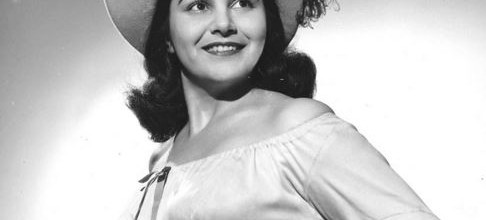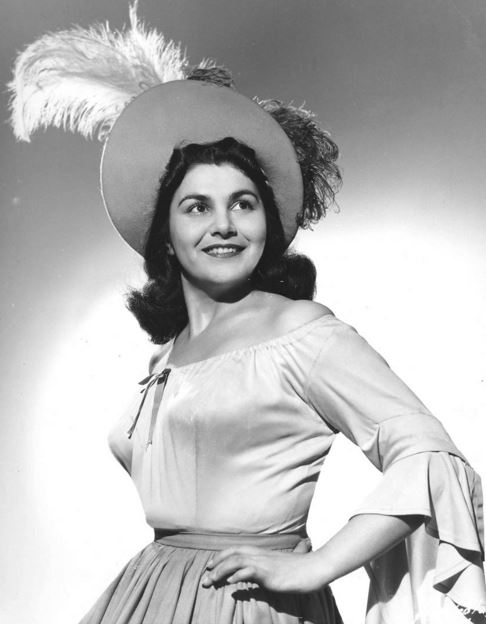Her Voice Sounds Like a Magnificent Violin: On the 90th Birthday of Lucine Amara

The article below was originally written in Armenian by Henrik Anassian. It was recently translated into English and edited by Arevig Caprielian.
On March 2, 2015, notable musicians, musicologists, and artists from nearby states gathered in New York city to celebrate in splendid setting the 90th birthday of Lucine Amara, a sublime Armenian singer, the treasured diva of the Metropolitan Opera.
Lucine Amara appeared on the stage of the globally acclaimed Metropolitan Opera in 882 productions, depicting 56 roles, which have often been broadcasted by radio and television. Amara is the only singer in the world who has sung at the same opera house for more than 40 years, not counting her performances for television and radio, her recordings and participation in films.
Lucine Amara has performed the principal roles in G. Bizet’s “Carmen,” G. Puccini’s “Madame Butterfly” and “La Boheme,” Tchaikovsky’s “Eugene Onegin,” J. Offenbach’s “The Tales of Hoffmann” (Les Contes D’Hoffmann), W.A. Mozart’s “Don Giovanni,” R. Leoncavallo’s “Pagliacci,” G. Verdi’s “Il Trovatore” and “Aida,” to name just a few.
For the past 20 years, she has been the artistic director of the New Jersey Association of Verismo, where talented young vocalists develop their art under her immediate attention and guidance.
Lucine (Tagouhie, meaning “queen” in Armenian) Armaghanian-Amara is the daughter of Adrine and Georg Armaghanian, survivors of Armenian Genocide of 1915. To the question regarding the altering of her name, L. Amara replied: “Lucine is the moon [in Armenian], as you know it, armaghan means a gift, but I’ve changed it to Amara, which means bitter, unkind in Italian.”
Amara was born on March 1, 1925 in Hartford, Conn. Initially, she studied at San Francisco’s Community Music School as a violinist, simultaneously singing in the choir of a local Armenian church, thus learning the liturgy, classical hymns, and canticles.
Soon, thanks to her naturally beautiful voice, the gifted young singer was trusted with solo parts. The appreciation of Armenian parishioners encouraged Amara. By the definition of her listeners, she possessed an “angelic voice,” and for that very reason she was advised to take vocal training lessons instead of continuing her current studies.
Following the advice of relatives and close friends, Amara began her studies with Richard Bonelli at the Music Academy of the West.
The years 1945-46 became memorable in Amara’s artistic career, marking her stage debut at the War Memorial Opera House as a chorus member…as a contralto! In 1948, she won the first prize at the Atwater Kent competition. In 1949, her teacher, Stella Eisner-Eyn, decided that Amara should participate in the auditions at the Metropolitan Opera and the almighty Fortuna smiled upon our compatriot: She was given a “young artist” contract. In 1950, her rendition of “Celestial Voice” (“Voice From Heaven”) in G. Verdi’s “Don Carlos” was defined by the critics as an unprecedented interpretation and an off-stage success. Celebrated violinist Isaac Stern once remarked, “Your singing sounds like a magnificent violin.”
Thus, in 1950 began Lucine Amara’s glorious artistic career—not only within the walls of the Metropolitan Opera house but also on the stages of famed opera houses throughout the world.
Despite her crowded schedule, Amara found time to record G. Verdi’s “Requiem” and L. van Beethoven’s “Symphony No. 9,” consequently acclaimed as one of the best performances of that work. Amara appeared with famous Italian tenor Mario Lanza in “The Great Caruso” film and recorded “Pagliacci” with Franco Corelli.
Among others, Amara worked with such prominent conductors and artistic directors as James Levine, Dimitri Mitropoulos, Eugene Ormandy, Leonard Bernstein, Leopold Stokowsky, and Pierre Monteux. She shared the stage with Franco Corelli, Carlo Bergonzi, Nicolay Gedda, Placido Domingo, Luciano Pavarotti, Jan Peerce, Richard Tucker, Jon Vickers, and other virtuosi of the vocal art. As readers may have noticed, Amara often sang with Italian singers. For several decades, the Metropolitan Opera had two prominent principal singers of Armenian descent: Lucine Amara and contralto Lili Chookasian (Chookaszian).
With her powerful talent, Lucine Amara conquered the best stages. Her preferred roles are in W.A. Mozart, G. Puccini, and G. Verdi repertoire.
It is a commonly known fact that the cradle of the art of opera is Italy, and a still more widely known fact that only exceptionally talented performers succeed in winning the love and appreciation of Italians.
Having thoroughly researched innumerable nuances comprising the facets of “Bel Canto” and having listened to many a singer well-versed in that style, Amara is firmly set as one of the stars in the constellation, symbolizing Armenian singers at the Metropolitan opera in New York—one of the most esteemed opera houses of the world. Other memorable singers are Armand Tokatyan, Ara Berberian, and Lili Chookasian. (It is worth mentioning another contemporaneous actor-singer and fellow Armenian, Michael Kermoyan (baritone), celebrated for his stellar performance in “The King and I.”) That brilliant “constellation” of Armenian stars will shine forever in the history of Metropolitan Opera, proving that we, Armenians, as one of the ancient nations of the world, have truly made significant contributions to the universal sphere of arts and culture.
It is a different issue, as to how many more such stars we could have had in the arts, sciences, and culture if Turkey had not broken the spine of our nation by annihilating our intelligentsia.
For Amara, it would not suffice to capture the audience solely with her beautiful voice. No, not so at all for her. The art of opera is a musical drama, a theater, in which each participant must display perfect acting, as required from actors of dramatic theatre.
While Lucine Amara’s acting is superb, her majestic voice flows like an abundant river, like honey—thick and vigorous when appropriate, and at times sorrowful and celestial.
Generally, any singer’s art, especially the strength of the voice, the capacity and vibrations of the vocal cords, are measured by singing gently, sotto voce. Singing loudly is relatively easy, while singing softly is far more difficult.
The ability to sing softly is a special art. Amara concurs with this mentality. She is capable of singing softly with an incredibly masterly command. While singing softly, her vocal resonation, timbre, and color are never reduced. Her renditions are inherently refined and typically there are no changes of timbre within her vocal range (diapason).
Sotto voce stems from “Bel Canto.” Examples of the former are ample in Armenian canticles, the folk songs of peasants, in laments of those exiled longing for the motherland and in heroic song narratives (sagas).
Amara’s accomplished renditions in the romantic and verismo styles are highly esteemed and admired by vast Italian audiences in Italy, the very cradle of operatic art.
For decades, Amara appeared in principal roles at the season openings of the Metropolitan Opera. The Times deftly qualified Lucine Amara as “the greatest lyric soprano of our times.” Time Magazine stated: “She brought to the stage the kind of dazzling vocal splendor that made the Met famous…” and “Lucine Amara is a superstar by longevity; a phenomenal vocal and dramatic artist of the highest order.” In reviews for W. A. Mozart’s “The Magic Flute,” we read: “Mozart’s opera was revived at the Metropolitan opera thanks to Lucine Amara.” We also encounter in the press of the period: “Lucine Amara is the pride of Metropolitan.”
The extraordinarily beautiful voice, flexible vocal cords, and splendid stage presence of Amara have enraptured her audiences at her concerts. As witnessed by her concert programs, alongside celebrated arias and vocal works of Western European composers, Amara always performed songs and romances by Armenian composers.
Music lovers of our country relished Lucine Amara’s live performances twice (1965 and 1991) with passionate, reverent emotion. I, too, was present at her concert in 1965, with the official responsibility of overseeing the live radio broadcast of the concert of this inimitable singer. The frenetic ovations of the audience made Amara sing encore three additional times. Poet Paruyr Sevak described his impression of the concert in these words: “Amara turned us into violins and played on the [strings] of our emotions.”
After the resonate success of her concert in 1991, Amara postponed other scheduled concerts. Instead, she chose to record a large number of Armenian songs and romances with the State Radio of Armenia. Is there a better expression of patriotism than this act of love?
In 1991, at age 66, Amara left the stage of the Metropolitan Opera, but remained professionally active, singing at concerts, coaching, and working on music-related projects. Currently, Amara and her daughter, Evelyn (also an opera singer, voice teacher, and stage director) give master classes in the United States, Canada, Australia, and Mexico.
Doubtless, besides being an American operatic artist, Amara is also an Armenian by her heritage, temperament, and imagination. Although American-born, she has never been solely American. Amara speaks Armenian fluently, maintains close ties with the Armenian community and the Armenian Apostolic Church, and honors and practices Armenian traditions and customs.
Occasionally, even at her respectable age of 90, she performs cherished Armenian songs and romances at events within the Armenian and American communities.
We conclude by thanking, on behalf of true lovers of music, this universally acclaimed Armenian singer, Lucine Amara, on the occasion of her 90th birthday and wish her good health. We assure her that she has been, is, and will always be one of the world titans of the art of opera. Lucine Amara will forever be one of the stars in the constellation of Armenian artists at the Metropolitan Opera. That star is our pride. We ought to strive to deserve that pride.
Source: Armenian Weekly Mid-Atlantic

